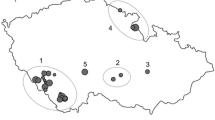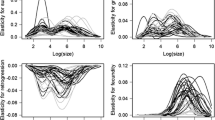Abstract
Small populations of founding individuals or survivors of incomplete management programs often represent critical transitions in biological invasions. Theory predicts that population size affects reproduction and, consequently, a population’s expansion, but there are few empirical tests, and fewer that account for the reduced genetic diversity that often accompanies small population size. We created experimental small populations of invasive ryegrass (Lolium multiflorum) with population size varying independently from genetic diversity. Treatment independence was achieved by cloning plants to increase population size without changing diversity. Plant fitness was measured as the proportion of florets producing a seed. We analyzed the effects of population size, genetic diversity, and their interaction using ANCOVAs, one of which accounted for variation in individual plant growth. As predicted, smaller populations produced significantly lower proportion seed set. Low genetic diversity also reduced seed set, but this was best interpreted as part of a significant interaction with population size. Specifically, the effect of population size on the proportion seed set was over five times larger for populations in the medium genetic diversity treatment than the highest diversity treatment, and 6.7 times larger for populations with the lowest level of diversity. Population size variation had biologically meaningful consequences, as the rate of seed set within the low diversity treatment increased by 80 % with increasing population size. The results indicate that both the demographics and genetics of populations can influence reproduction and invasive potential, and must be considered when assessing risk and designing management plans for invasive plants.



Similar content being viewed by others
References
Ahlroth P, Alatalo RV, Holopainen A, Kumpulainen T, Suhonen J (2003) Founder population size and number of source populations enhance colonization success in waterstriders. Oecologia 137:617–620
Aigner PA (2004) Ecological and genetic effects on demographic processes: pollination, clonality and seed production in Dithyrea maritima. Biol Conserv 116:27–34
Aizen MA, Harder LD (2007) Expanding the limits of the pollen-limitation concept: effects of pollen quantity and quality. Ecology 88:271–281
Allee WC, Park O, Emerson AE, Park T, Schmidt KP (1949) Principles of animal ecology. Saunders, Philadelphia
Berec L, Angulo E, Courchamp F (2007) Multiple Allee effects and population management. Trends Ecol Evol 22:185–191
Burd M (1994) Bateman’s principle and plant reproduction-the role of pollen limitation in fruit and seed set. Bot Rev 60:83–139
Byers DL (1995) Pollen quantity and quality as explanations for low seed let in small populations exemplified by Eupatorium (Asteraceae). Am J Bot 82:1000–1006
California Invasive Plant Council (2004) Weed worker’s handbook. California Invasive Plant Council, Berkeley
Cheptou P-O, Dieckmann U (2002) The evolution of self-fertilization in density-regulated populations. Proc R Soc Lond B 269:1177–1186
Colautti RI, Grigorovich IA, MacIsaac HJ (2006) Propagule pressure: a null model for biological invasions. Biol Invasions 8:1023–1037
Crampton B (1974) Grasses in California. University of California Press, Berkeley
Crawford KM, Whitney KD (2010) Population genetic diversity influences colonization success. Mol Ecol 19:1253–1263
Davis HG, Taylor CM, Lambrinos JG, Strong DR (2004) Pollen limitation causes an Allee effect in a wind-pollinated invasive grass (Spartina alterniflora). Proc Natl Acad Sci USA 101:13804–13807
Dawson K, Veblen KE, Young TP (2007) Experimental evidence for an alkali ecotype of Lolium multiflorum, an exotic invasive annual grass in the Central Valley, CA, USA. Biol Invasions 9:327–334
Dawson W, Mndolwa AS, Burslem DFRP, Hulme PE (2008) Assessing the risks of plant invasions arising from collections in tropical botanical gardens. Biodivers Conserv 17:1979–1995
Drake JM, Lodge DM (2006) Allee effects, propagule pressure and the probability of establishment: risk analysis for biological invasions. Biol Invasions 8:365–375
Drury KLS, Drake JM, Lodge DM, Dwyer G (2007) Immigration events dispersed in space and time: factors affecting invasion success. Ecol Model 206:63–78
Elam D, Ridley CE, Goodell K, Ellstrand NC (2007) Population size and relatedness affect fitness of a self-incompatible invasive plant. Proc Natl Acad Sci USA 104:549–552
Ellers J, Rog S, Braam C, Berg MP (2011) Genotypic richness and phenotypic dissimilarity enhance population performance. Ecology 92:1605–1615
Ellstrand NC, Schierenbeck KA (2000) Hybridization as a stimulus for the evolution of invasiveness in plants? Proc Natl Acad Sci USA 97:7043–7050
Fearon CH, Hayward MD, Lawrence MJ (1983) Self-incompatibility in ryegrass V. Genetic control, linkage and seed-set in diploid Lolium multiflorum. Heredity 50:35–46
Gerhardt F, Collinge SK (2003) Exotic plant invasions of vernal pools in the Central Valley of California, USA. J Biogeogr 30:1043–1052
Goodell K, McKinney AM, Lin C-H (2010) Pollen limitation and local habitat-dependent pollinator interactions in the invasive shrub Lonicera maackii. Int J Plant Sci 171:63–72
Hendry GW (1931) The Adobe brick as a historical source: reporting further studies in adobe brick analysis. Agric Hist 5:110–127
Jasieniuk M, Ahmad R, Sherwood AM, Firestone JL, Perez-Jones A, Lanini WT, Mallory-Smith C, Stednick Z (2008) Glyphosate-resistant Italian ryegrass (Lolium multiflorum) in California: distribution, response to glyphosate, and molecular evidence for an altered target enzyme. Weed Sci 56:496–502
Kramer AM, Dennis B, Liebhold AM, Drake JM (2009) The evidence for Allee effects. Pop Ecol 51:341–354
Lafuma L, Maurice S (2007) Increase in mate availability without loss of self-incompatibility in the invasive species Senecio inaequidens (Asteraceae). Oikos 116:201–208
Leung B, Drake J, Lodge D (2004) Predicting invasions: propagule pressure and the gravity of Allee effects. Ecology 85:1651–1660
Liebhold A, Bascompte J (2003) The Allee effect, stochastic dynamics and the eradication of alien species. Ecol Lett 6:133–140
Liu H, Pemberton RW, Stiling P (2006) Native and introduced pollinators promote a self incompatible invasive woody vine (Paederia foetida) in Florida. J Torrey Bot Soc 133:304–311
Miller JS, Levin RA, Feliciano NM (2008) A Tale of two continents: Baker’s Rule and the maintenance of self-incompatibility in Lycium (Solanaceae). Evolution 62:1052–1065
Morrison SA, Macdonald N, Walker K, Lozier L, Shaw MR (2007) Facing the dilemma at eradication’s end: uncertainty of absence and the Lazarus effect. Front Ecol Environ 5:271–276
Okada M, Ahmad R, Jasieniuk M (2007) Microsatellite variation points to local landscape plantings as sources of invasive pampas grass (Cortaderia selloana) in California. Mol Ecol 16:4956–4971
Parker IM (1997) Pollinator limitation of Cytisus scoparius, an invasive exotic shrub. Ecology 78:1457–1470
Rasband WS (2007) ImageJ ver. 1.38s, U.S. National Institutes of Health, Bethesda, Maryland, USA. http://rsb.info.nih.gov/ij/
Ross KG, Shoemaker DD (2008) Estimation of the number of founders of an invasive pest insect population: the fire ant Solenopsis invicta in the USA. Proc R Soc Lond B 275:2231–2240
Sherwood A, Jasieniuk M (2009) Molecular identification of weedy glyphosate-resistant Lolium (Poaceae) in California. Weed Res 49:354–364
Sih A, Baltus M-S (1987) Patch size, pollinator behavior and pollinator limitation in catnip. Ecology 68:1679–1690
Sloop CM, Ayres DR, Strong DR (2008) The rapid evolution of self-fertility in Spartina hybrids (Spartina alterniflora × foliosa) invading San Francisco Bay, CA. Biol Invasions 11:1131–1144
Stanton ML (1987) Reproductive biology of petal color variants in wild populations of Raphanus sativus: I. Pollinator response to color morphs. Am J Bot 74:178–187
Stephens PA, Sutherland WJ (1999) Consequences of the Allee effect for behaviour, ecology and conservation. Trends Ecol Evol 14:401–405
Stephens PA, Sutherland WJ, Freckleton RP (1999) What is the Allee effect? Oikos 87:185–190
Taylor CM, Hastings A (2004) Finding optimal control strategies for invasive species: a density-structured model for Spartina alterniflora. J Appl Ecol 41:1049–1057
Taylor CM, Hastings A (2005) Allee effects in biological invasions. Ecol Lett 8:895–908
Tobin PC, Robinet C, Johnson DM, Whitmire SL, Bjørnstad ON, Liebhold AM (2009) The role of Allee effects in gypsy moth, Lymantria dispar (L.), invasions. Popul Ecol 51:373–384
Tobin PC, Berec L, Liebhold AM (2011) Exploiting Allee effects for managing biological invasions. Ecol Lett 14:615–624
van Kleunen M, Johnson SD (2005) Testing for ecological and genetic Allee effects in the invasive shrub Senna didymobotrya (Fabaceae). Am J Bot 92:1124–1130
van Kleunen M, Johnson SD (2007) Effects of self-compatibility on the distribution range of invasive European plants in North America. Conserv Biol 21:1537–1544
von Holle B, Simberloff D (2005) Ecological resistance to biological invasion overwhelmed by propagule pressure. Ecology 86:3212–3218
Wagenius S, Lonsdorf E, Neuhauser C (2007) Patch aging and the S-allee effect: breeding system effects on the demographic response of plants to habitat fragmentation. Am Nat 169:383–397
Ward M, Johnson SD, Zalucki MP (2012) Modes of reproduction in three invasive milkweeds are consistent with Baker’s Rule. Biol Invasions 14:1237–1250
West B, Welch KB, Galecki AT (2007) Linear Mixed Models: A Practical Guide Using Statistical Software. Chapman and Hall/CRC, Boca Raton
Willi Y, van Buskirk J, Fischer M (2005) A threefold genetic Allee effect: population size affects cross-compatibility, inbreeding depression and drift load in the self-incompatible Ranunculus reptans. Genetics 169:2255–2265
Yamanaka T, Liebhold AM (2009) Mate-location failure, the Allee effect, and the establishment of invading populations. Popul Ecol 51:337–340
Acknowledgments
J.L.F. was supported by a graduate student award from an endowment of the Department of Plant Sciences. Financial support for this research was provided by UC Davis departmental startup funds to M.J. We appreciate statistical help from Scott Steinmaus, and advice on the research and writing from Kevin Rice and Sharon Strauss. Jim Jackson’s field crew, Guy Kyser, Bill Pfender of the USDA Agricultural Research Service, and Pamela Riley ensured the survival of plants. Tom Lanini provided information on sampling locations. The Indiana Statistical Consulting Center clarified several points for us. Anonymous reviewers made important suggestions on an earlier version of the manuscript. The first author also thanks Dennis McFaden for training and inspiration. The authors declare that they have no conflict of interest and that experiments complied with the current laws of the country in which the experiments were performed.
Author information
Authors and Affiliations
Corresponding author
Additional information
Communicated by Miguel Franco.
Rights and permissions
About this article
Cite this article
Firestone, J.L., Jasieniuk, M. Small population size limits reproduction in an invasive grass through both demography and genetics. Oecologia 172, 109–117 (2013). https://doi.org/10.1007/s00442-012-2465-y
Received:
Accepted:
Published:
Issue Date:
DOI: https://doi.org/10.1007/s00442-012-2465-y




